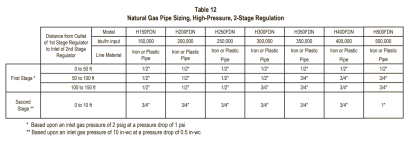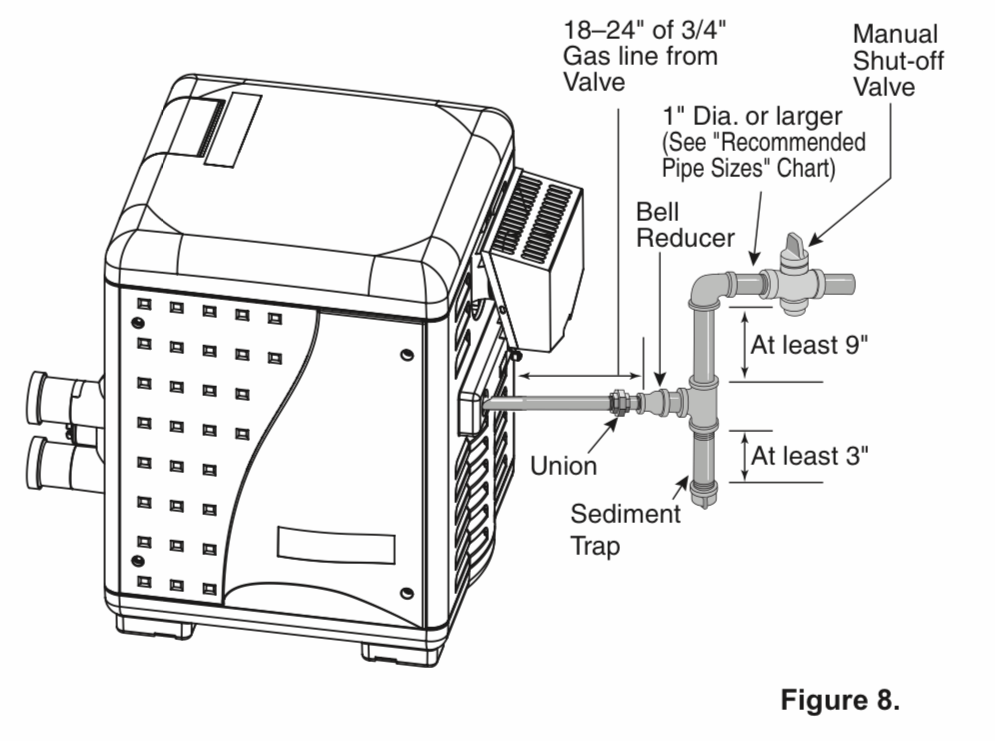Hayward Heater - Gas Valve - Why Do These Fail?
- Thread starter MWC
- Start date
You are using an out of date browser. It may not display this or other websites correctly.
You should upgrade or use an alternative browser.
You should upgrade or use an alternative browser.
- Jul 18, 2024
- 105
- Pool Size
- 23
- Surface
- Vinyl
- Chlorine
- Salt Water Generator
- SWG Type
- Hayward Aqua Rite (T-15)
I’ll try to get specifics and post on all these. Thanks. Some of these questions are outside my knowledge base at moment. I’ll see what can figure out.
It says 6 to 10.5" w.c.
View attachment 476834
It says 4.5 to 10.5" w.c.

It's basically the same thing.
The meter will put out either low pressure (about 7.0" to 13.8538" w.c (0.5 psi)) or high pressure (about 2 psi).
If the meter puts out 2 psi, then you use a regulator near the appliance to drop the pressure to about 7.5" w.c.
The meter is not going to put out 4" w.c.
Normal output is about 1/4 psi to 1/2 psi.
0.25 psi is 6.9269" w.c.
If the pressure is lower than 7", then it is too low and it should be increased.
As long as the line is sized correctly, the pressure will be fine.
You will have a static pressure and a dynamic pressure.
Static is when the heater is off and dynamic is when the heater is running.
The dynamic should not be more than about 0.5" w.c lower than the static.
The dynamic should not be lower than the minimum.
Don't worry about the manifold pressure.
As long as the supply inlet dynamic pressure is above the minimum, the manifold should be fine.
Can you show your meter data plate?
What is your current pressure?
View attachment 476835
View attachment 476836

For 2 psi service, 3/4" line is ok, but you need a regulator near the heater to drop the pressure to the heater specifications.
2 psi with no regulator can damage the gas valve.
This is natural gas and not propane, right?
2 psi with no regulator can damage the gas valve.
This is natural gas and not propane, right?
- Jul 21, 2013
- 65,062
- Pool Size
- 35000
- Surface
- Plaster
- Chlorine
- Salt Water Generator
- SWG Type
- Pentair Intellichlor IC-60
This sediment trap is incorrectly installed.
The correct sediment trap design is for the gas to make a 90 degree turn to go into the heater while the sediment can drop down into the sediment trap as shown in the Pentair diagram below. We see many gas line installations with the gas going straight and the sediment trap on a 90 degree bend. The sediment will not make that turn and continue into the gas valve eventually causing it to fail.


The correct sediment trap design is for the gas to make a 90 degree turn to go into the heater while the sediment can drop down into the sediment trap as shown in the Pentair diagram below. We see many gas line installations with the gas going straight and the sediment trap on a 90 degree bend. The sediment will not make that turn and continue into the gas valve eventually causing it to fail.

- Jul 18, 2024
- 105
- Pool Size
- 23
- Surface
- Vinyl
- Chlorine
- Salt Water Generator
- SWG Type
- Hayward Aqua Rite (T-15)
Last edited:
- Jul 18, 2024
- 105
- Pool Size
- 23
- Surface
- Vinyl
- Chlorine
- Salt Water Generator
- SWG Type
- Hayward Aqua Rite (T-15)
Believe 1.0 inch black pipe, OD would be the 1.315 I think. I am using a tape measure and I thought it was 1.5 or close to it. But I know it’s 1 inch pipe.
Last edited:
- Jul 18, 2024
- 105
- Pool Size
- 23
- Surface
- Vinyl
- Chlorine
- Salt Water Generator
- SWG Type
- Hayward Aqua Rite (T-15)
- Jul 18, 2024
- 105
- Pool Size
- 23
- Surface
- Vinyl
- Chlorine
- Salt Water Generator
- SWG Type
- Hayward Aqua Rite (T-15)
- Jul 18, 2024
- 105
- Pool Size
- 23
- Surface
- Vinyl
- Chlorine
- Salt Water Generator
- SWG Type
- Hayward Aqua Rite (T-15)
Nat gas yes.For 2 psi service, 3/4" line is ok, but you need a regulator near the heater to drop the pressure to the heater specifications.
2 psi with no regulator can damage the gas valve.
This is natural gas and not propane, right?
- Jul 18, 2024
- 105
- Pool Size
- 23
- Surface
- Vinyl
- Chlorine
- Salt Water Generator
- SWG Type
- Hayward Aqua Rite (T-15)
It’s one inch pipe for sure. I’ll measure OD properly but that would mean 1.315.There is no 1.5" OD pipe.
We need an exact measurement.
Not approximate.
Not guesses or assumptions.
It should exactly match one of these.
Get a caliper.
View attachment 641143
Last edited:
- Jul 18, 2024
- 105
- Pool Size
- 23
- Surface
- Vinyl
- Chlorine
- Salt Water Generator
- SWG Type
- Hayward Aqua Rite (T-15)
I’ll put in on paper. I think I’m right under 30 equivalent just estimating in my head.
18 + (6) 2.62 = about 34 feet.
If you have 8" w.c supply, you might be allowed up to a 3" w.c pressure drop, which will allow up to 200 feet of 1" pipe.
Note, the manual indicates a minimum of 1-1/4" pipe and the manual should usually be followed.
Verify all design plans with a licensed qualified gas contractor before deciding what to do.


If you have 8" w.c supply, you might be allowed up to a 3" w.c pressure drop, which will allow up to 200 feet of 1" pipe.
Note, the manual indicates a minimum of 1-1/4" pipe and the manual should usually be followed.
Verify all design plans with a licensed qualified gas contractor before deciding what to do.














